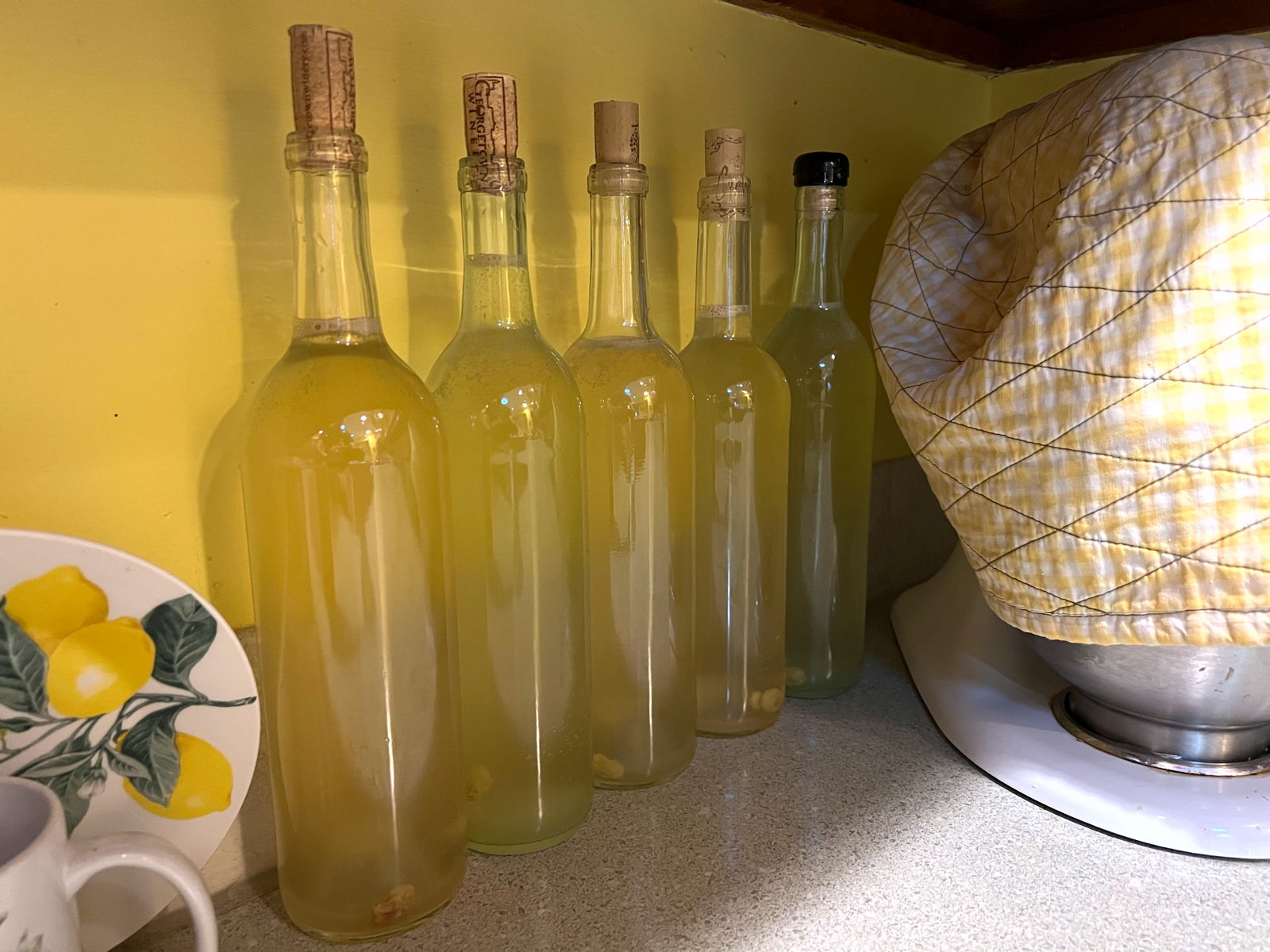Hope Lutheran 1950 Lenten fish au gratin

I’m not necessarily going to cover every month in the 1950 calendar I posted just before the New Year. While I will be making a recipe from every month, I expect that some months won’t justify a post. For example, I wasn’t going to do a post for March’s calendar recipe. The fish au gratin I made was fine but I didn’t have enough to say about it to justify a post.
But there is something about it to justify an unfocused ramble. One of the interesting things about a cookbook that is also a calendar over half a century old is that it follows seasons that no longer exist.
In the Catholic Church, in 1950, abstinence lasted nearly the entire period of Lent, not merely Fridays.1 Easter in 1950 was the same date as this year in 2023 and that means that like this year, the entire month of March 1950 was Lent.2

A bottle of fine vintage mead… one year old, anyway, that has been in my fridge since I made it in early 2022.
From what I can tell, in the Catholic Church it wasn’t until 1962 that abstinence was relegated to Fridays3 I suspect there was something similar at Hope Lutheran as well, because every recipe in March was seafood. It was only when I started thinking about that that I decided to do this post.
Now, this calendar is not a Catholic calendar: Hope Lutheran is, obviously, Lutheran. Specifically, Missouri Synod Lutheran.
Lutherans are not as strict about fasting as the Catholic church; they believe that Catholics focus so much on fasting that they forget what the fasting is about.4 Modern Lutherans appear to mostly leave fasting up to the individual, But the Missouri Synod does seem to take fasting more seriously than others. In 2016, Grace Evangelical in Tulsa seemed to recommend Fasting from Ash Wednesday until Easter Sunday; Abstinence on all Fridays. In general, the5 Missouri Synod website also explains that fasting and abstinence are an aspirational part of the ancient church.
Each of the seasons of the church year is observed and celebrated, but Lent, and only Lent, is “kept.” The holy season of Lent invites us to be “keepers”—the people of God who keep the fast, keep the silence, and keep the focus throughout this singular season.
…
In the early church, people fasted for different lengths of time and abstained from various foods. In a 604 letter to Bishop Augustine of Canterbury, St. Gregory the Great (commemorated on Sept. 3 in LSB) wrote: “We abstain from flesh meat and from all things that come from flesh, as milk, cheese, and eggs.”
Whether individuals keep it or not, this is a church calendar as well as a cookbook, and so it has to be aspirational as much as practical in order to be practical.
I don’t know whether the Missouri Synod or Hope Lutheran or its members were more strict in 1950. But this calendar certainly seems to indicate that enough people took abstinence seriously that they provided only seafood recipes during March.
I chose the fish au gratin mostly because I enjoy fish and I almost never make it for myself. It’s something I get when I go out, whether it’s a really nice seafood place or a deli tuna salad melt.6
This recipe uses some interesting techniques. You’re basically steaming the fish in milk; the milk isn’t going to boil very long, if it boils at all, in the oven for only half an hour. The recipe called for covering the pan with “oiled paper”. Not having any oiled paper, I used wax paper and held it down with four squares of tinfoil at the corners wrapped under the edges.
Once steamed, the fish is moved to a new pan—presumably with the onion, or at least, I did. The milk is discarded. It will have curdled; it might not boil but it will definitely reach 180° and there’s nothing in it to keep it intact. In fact, however, the milk tasted very good despite being curdled. I poured it into a jar and drank it for breakfast the next morning. I didn’t strain it while saving it but you certainly could if you prefer a smoother texture.
Were I to make it again I would probably add a few slices of jalapeño and/or some fresh ginger root along with the onion. Not only would this make the fish taste better, it would make my next-morning’s beverage taste more breakfasty!

Fish au Gratin
Servings: 6
Preparation Time: 1 hour
A 1950 recipe calendar for 2023
Hope Lutheran 1950 calendar of recipes (PDF File, 11.7 MB)
Ingredients
- 3 lbs fish fillets, 1-inch thick
- 1-½ cups milk
- 1 sliced onion
- salt
- pepper
- ⅓ cup grated cheese
Steps
- Pour milk into buttered baking pan.
- Pat fish dry and place into pan.
- Slice onion and put slices on top of the fish.
- Season with salt and pepper.
- Cover with wax paper, possibly securing the corners with aluminum foil or some other fastener.
- Bake at 350° for 30 minutes.
- Remove the fish and onions to another greased pan.
- Sprinkle grated cheese over the top.
- Continue baking just long enough to melt the cheese.
Of course, that recipe doesn’t give you anything you don’t already have. It’s in the calendar (PDF File, 9.4 MB). So to give you a recipe that isn’t in the calendar, what goes good with fish? A year ago I made some Finnish lemon mead from the Cooking of Scandinavia volume of Time-Life’s Foods of the World series. It was very good, but some people who have tried it mentioned that it gets even better with time. I thought now would be a perfect time to find out. It was light and moderately bubbly, something that goes perfect with lightly-flavored fish.
I took it out of the refrigerator and it looked very clear. I opened it up… and it was like opening champagne in the movies. Nearly the whole contents of the bottle spewed upward in a foamy white spray. I suspect that this is because the seal I used was a full seal and that there was no way to release the pressure slowly. Once the latch is moved, the full seal is off. When I make it again, I’m going to have to either drink it sooner or bottle it more appropriately for longer-term storage. There are mead bottling instructions on the web that include steps that were completely left out of the Time-Life version.

Finnish lemon mead (Sima)
Servings: 20
Preparation Time: 1 hour
Dale Brown
The Cooking of Scandinavia (Internet Archive)
Ingredients
- 2 large lemons
- ½ cup sugar
- ½ cup brown sugar
- 5 quarts boiling water
- ⅛ tsp yeast
- 5 tsp sugar
- 15 raisins
Steps
- Carefully peel the yellow skins of the lemons and set them aside.
- Cut away the white membranes and discard them.
- Slice the lemons very thin.
- In a 6-8 quart enameled or stainless steel bowl, combine the lemon slices, lemon skins, and ½ cup each of sugar and brown sugar.
- Pour the boiling water over the fruit and stir.
- Let cool to tepid.
- Stir in the yeast.
- Allow to ferment, uncovered, at room temperature, for about 12 hours.
- Bottle using five one-quart bottles with very tight covers or corks.
- Place 1 tsp of sugar and three raisins at the bottom of each bottle.
- Strain the liquid through a sieve.
- Use a funnel to pour the liquid into the bottles.
- Cork tightly and let stand at room temperature for 1-2 days until the raisins have risen to the surface.
- Chill the sealed bottles until ready to serve.
- Note that storing for longer than a few weeks may result in very high pressure. Use care when uncorking or opening.
Because this was extremely good, I definitely am going to replenish my refrigerator with it. It was clear, bubbly (obviously), and champagne-like. A wonderful flavor and texture.
But if you make it from these instructions, be very, very careful when you open it. I suggest doing it outside. That said, it’s worth the risk. This is good stuff.
In response to A 1950 recipe calendar for 2023: In October, a friend gave me this cool calendar of recipes from 1950. It turns out, 1950 is the same as 2023, right down to the date of Easter. Print it out and hang it if you wish, and happy New Year!
Because it was such a longer period, it also was more complicated than it is today. While that difference in general is what caused me to write this post, that difference in specifics is not something I want to get into.
↑This did not mean no meat during March. Sundays are never part of Lent, and, also, the rules were different because they were so extensive. But Sundays make a very small proportion of the month, and there are only four recipes for March in this calendar.
↑Further, up until those changes, abstinence applied to every Friday throughout the year.
↑And that, having forgotten, our focus is as much on loopholes to evade the rules as on the fasting itself. I may resemble that analysis occasionally.
↑Or, “a”? I don’t know how organized Missouri Synod is.
↑This, of course, is exactly the attitude that Lutherans complain about among Catholics.
↑
cookbooks
- 2023 Old Recipe Calendar (PDF File, 9.4 MB)
- A 1950 recipe calendar repurposed for printing and hanging in 2023.
- The Cooking of Scandinavia: Dale Brown at Internet Archive (ebook)
- “It has been said that the only thing we Scandinavians will own up to, in the name of fellowship amount our countries, is the Vikings.”
- Review: The Cooking of Scandinavia: Jerry Stratton at Jerry@Goodreads
- Denmark, Norway, Sweden, Finland. And Aquavit is its own country living among them. “When the nights are longest and the greater part of winter still stretches bleakly ahead… The only proper refuge from the darkness is home…”
fasting
- Fasting and Abstinence—Current and Traditional Practices
- “Catholics between the ages of 18 and 59 are obliged to fast on Ash Wednesday and Good Friday. In addition, all Catholics 14 years old and older must abstain from meat on Ash Wednesday, Good Friday and all the Fridays of Lent.” Includes current practice vs. 1962 Discipline.
- Grace Evangelical Lutheran Church Fasting Guidelines
- “Fasting and abstaining from food is not for everyone! It can be physically dangerous for some Christians, and spiritually dangerous to others.”
- Keeping a Holy Lent: Dr. Gregory J. Wismar
- “The custom of keeping the fast in Lent has been part of the holy observance of the season from its very beginnings. The biblical precedent for this custom is reflected in the very first hymn in the ‘Lent’ section of Lutheran Service Book: ‘O Lord, throughout these forty days You prayed and kept the fast’.”
More calendars
- A 1950 recipe calendar for 2023
- In October, a friend gave me this cool calendar of recipes from 1950. It turns out, 1950 is the same as 2023, right down to the date of Easter. Print it out and hang it if you wish, and happy New Year!
- Simple .ics iCalendar file creator
- A simple Perl script to create an ics file from a human-readable text of events.
More Catholicism
- Light a candle for Christmas hymns
- While the holidays brought more examples of bowdlerized lyrics they also brought, at least to our church, a lit candle for the darkness, in the form of a new hymnal that retains sound Catholic theology.
- Is the Catholic Church pro-human trafficking?
- “By their deeds shall they be known.” But by their deeds rather than their words, the Catholic Church is dangerously pro-human trafficking. And by elevating good intentions over deeds, they are falling dangerously into pagan thought.
More cookbooks
- My Year in Food: 2024
- From Italy, to San Diego, to Michigan, and many points in between; and from 1876 up to 2024 with stops in the 1920s, this has been a great food year.
- Mrs. Winslow’s Domestic Receipt Book for 1876
- If this is what people were eating in 1876, they were eating very well. From coconut pie to molasses gingerbread to tomato jam, these are great recipes—albeit requiring some serious interpretation.
- Stoy Soy Flour: Miracle Protein for World War II
- To replace protein lost by rationing, add the concentrated protein of Stoy’s soy flour to your baked goods and other dishes!
- Refrigerator Revolution Revisited: 1942 Cold Cooking
- Iceless refrigeration had come a long way in the fourteen years since Frigidaire Recipes. And so had gelatin!
- Rumford Recipes Sliding Cookbooks
- One of the most interesting experiments in early twentieth century promotional baking pamphlets is this pair of sliding recipe cards from Rumford.
- 68 more pages with the topic cookbooks, and other related pages
More Easter
- Easter Candy-Cane Ice Cream
- Candy canes are a shepherd’s staff. At Christmas, the shepherds were witnesses to Christ’s birth. By Easter, Christ is the good shepherd, giving his life for his lost lambs.
- Candy cane oatmeal crispies
- These candy cane cookies are a great way to use up post-Christmas candy canes. You might even want to hit the after-Christmas sales just to get canes to make these with.
More fish
- Something fishy in the state of Wisconsin
- Fish soup, fish salad, and fish gelatin. These are very fifties recipes—for better and for worse. Very worse.
- Salmon Curry Soup
- Very easy to make, this is a bright, beautiful, delectable cream of salmon soup. The yogurt and spices give it an almost lemony taste.
- Bacon scallops in dill sauce
- A bit fiddly, these bacon-wrapped scallops make a great party snack.
- Corn and clam soup
- Corn and clam soup with spinach, shrimp, and red bell pepper. Fast and easy.
- Hot tuna quinoa
- A bit of jalapeño, olives, wine, and fresh lime flavors and tuna and highlights the quinoa.
- One more page with the topic fish, and other related pages

